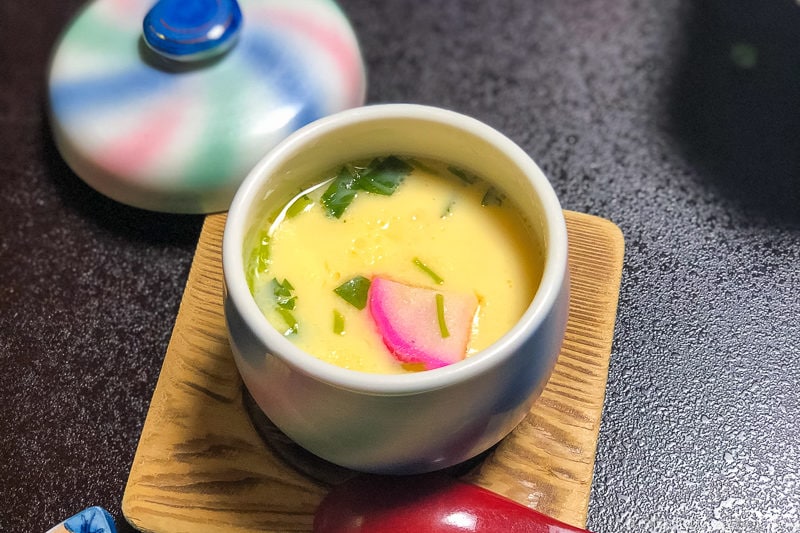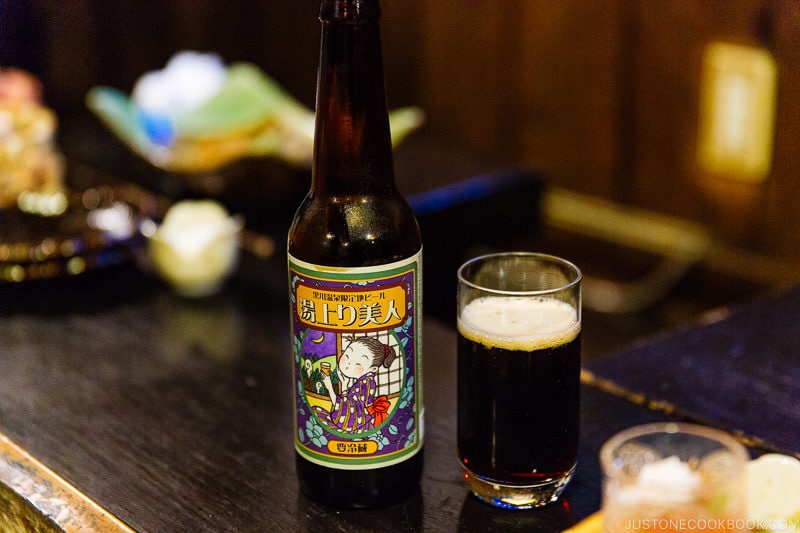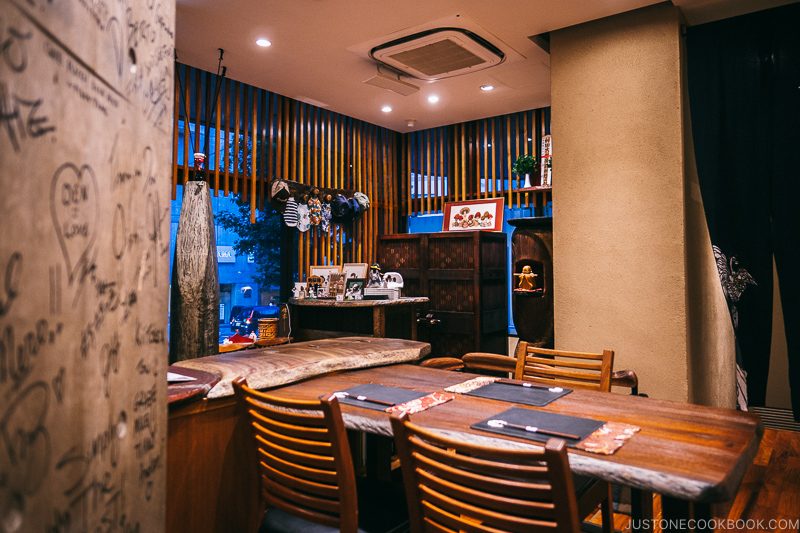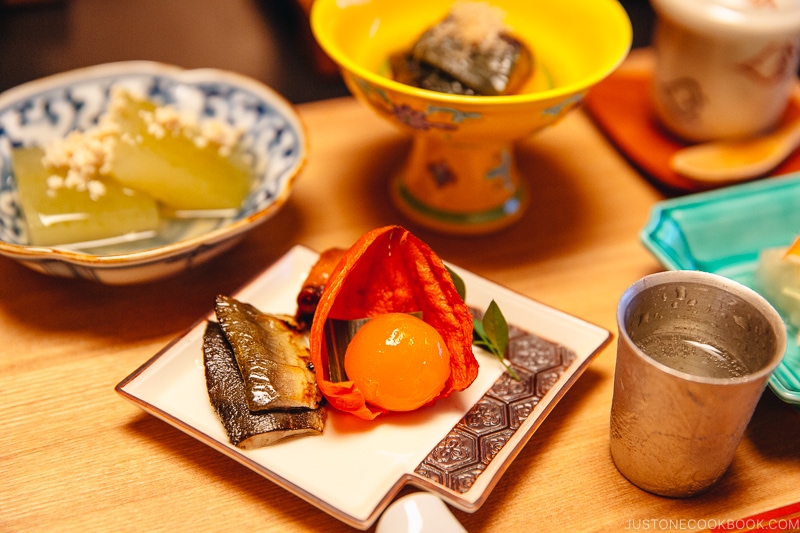
Kaiseki Ryori is a traditional Japanese multi-course meal served at high-end Japanese restaurants and inns. Learn more about the background, the various dishes served, and etiquette tips for your next special dinner outing.
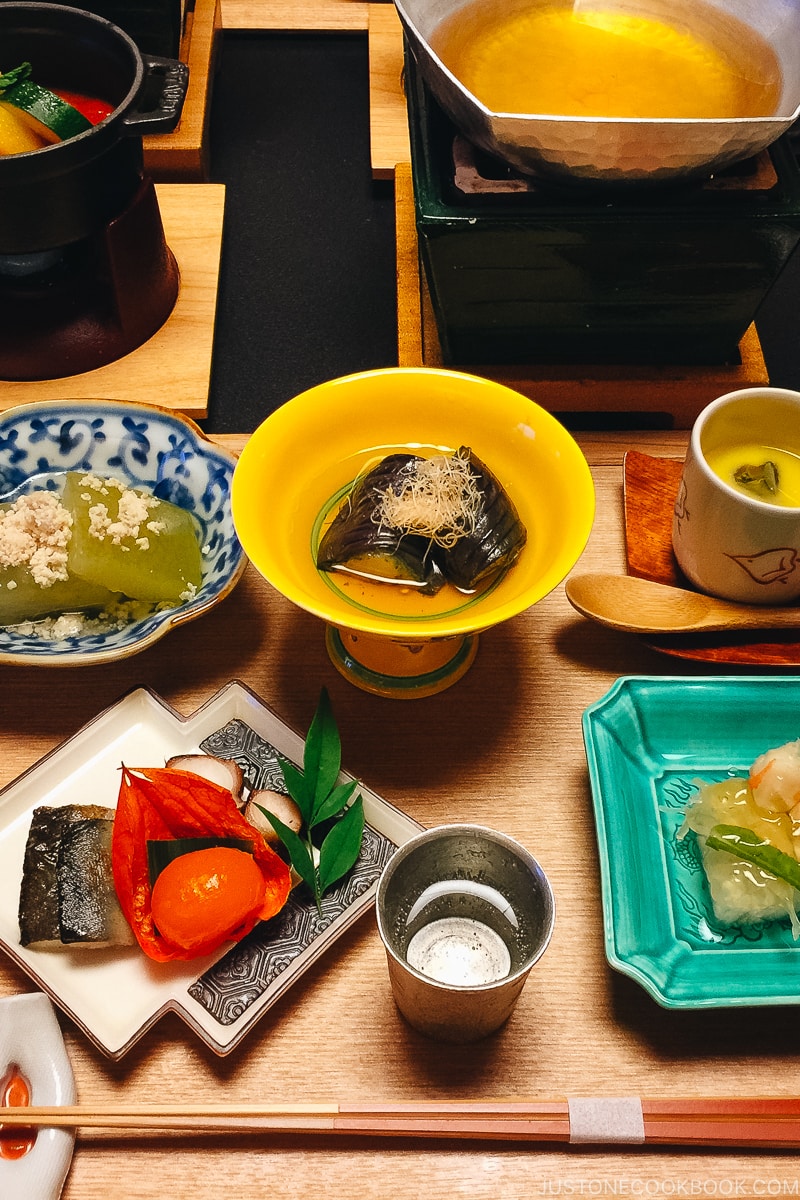
Far removed from the daily Japanese meal served at home, Kaiseki Ryori is a luxurious meal reserved for special occasions. You may have heard or seen images of the elaborate ordeal. The masterful presentation of plated dishes, the nod to seasonal ingredients, the exquisite spread of tableware. The tranquil setting and the most attentive hospitality.
At its core, Kaiseki Ryori is all about the celebration of the distinctive seasons and the craftsmanship of the Japanese culinary world. It is a feast and a full-sensory experience, a must-try culinary experience for any visitors to Japan.
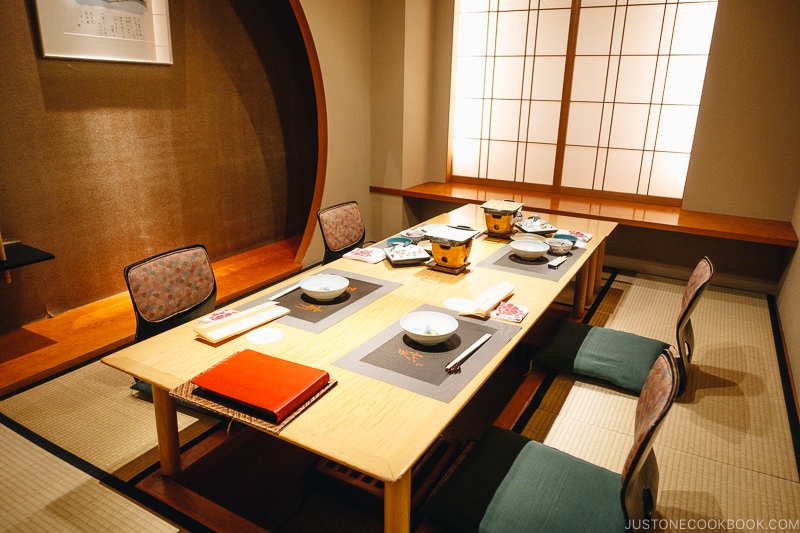
What is Kaiseki Ryori?
Described as Japanese haute cuisine, Kaiseki Ryori exemplifies the finest of Japanese values – harmony, balance, and appreciation for craftsmanship.
Background on Kaiseki Ryori
In Japanese, “Kaiseki” can be written in two ways: 懐石 and 会席. “Ryori” 料理 means cooking, cookery, or cuisine. While confusingly noted in two different ways yet pronounced the same, it has two distinct meanings.
Kaiseki, written as 懐石, or Cha-kaiseki (茶懐石) refers to a meal served at a Japanese tea ceremony, to stave off hunger pangs before tea. The meal was originally served to Buddhist monks and was simple and meditative. The term became widespread during the Azuchi-Momoyama Period (1573-1603) by Senno Rikyu (千利休), the founder of the Japanese tea ceremony. Over time, it developed into a multi-course elaborate meal with intricate dining rules.
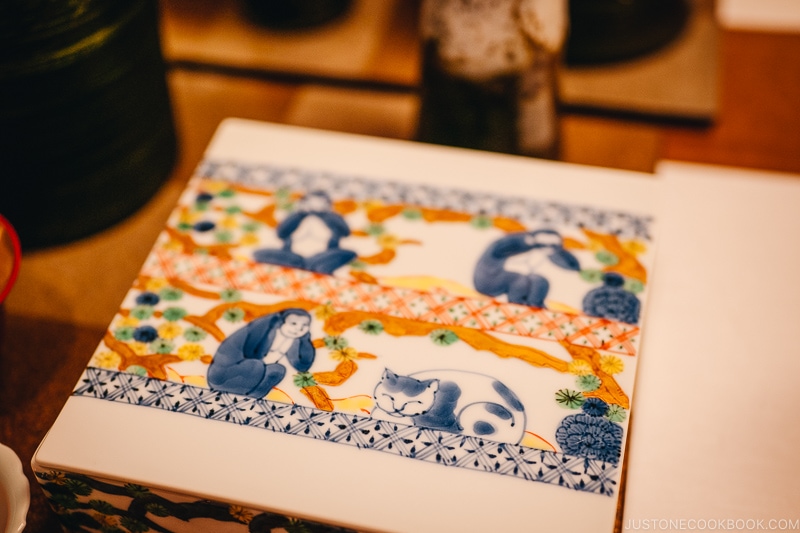
The latter Kaiseki, written as 会席, simply refers to a banquet dinner, oftentimes for a celebratory occasion. It is a condensed fusion of different dining styles originally reserved for the upper class and popularized among the merchant class during the Edo period (1603-1868). The Kaiseki restaurants you encounter are most likely this style.
Kaiseki is a dinnertime affair, but there are restaurants that offer a shortened (and therefore cheaper) Kaiseki lunch.
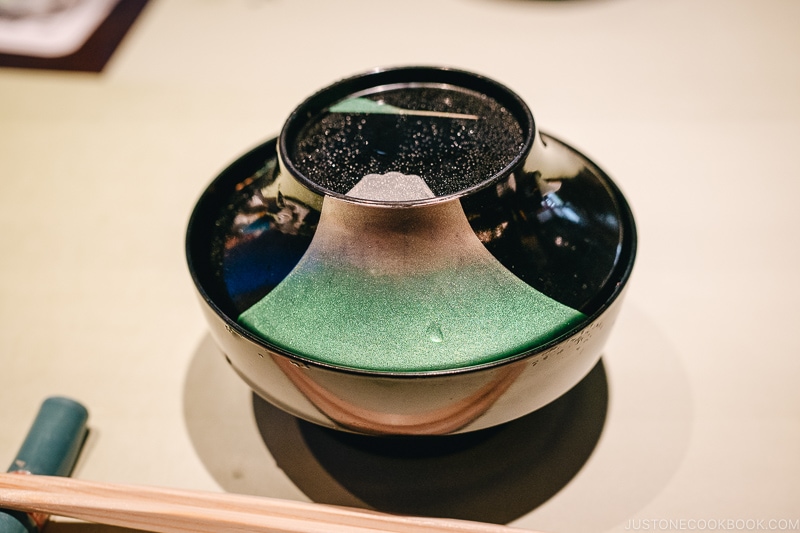
The Elements – Seasonality, Culinary Artistry & Hospitality
You can expect an all-embracing element of seasonality, culinary artistry, and hospitality at kaiseki meal. Every dish is painstakingly prepared with the freshest produce of the season, with each ingredient carefully crafted to highlight its essence.
Everything surrounding the meal also emphasizes the same principals. The decorative leaves and vegetable cuts on the serving wares, the flowers furnishing the restaurant, the Japanese hanging scrolls, the color scheme on the hostess’ kimono – each element is thoughtfully curated to complement the experience.
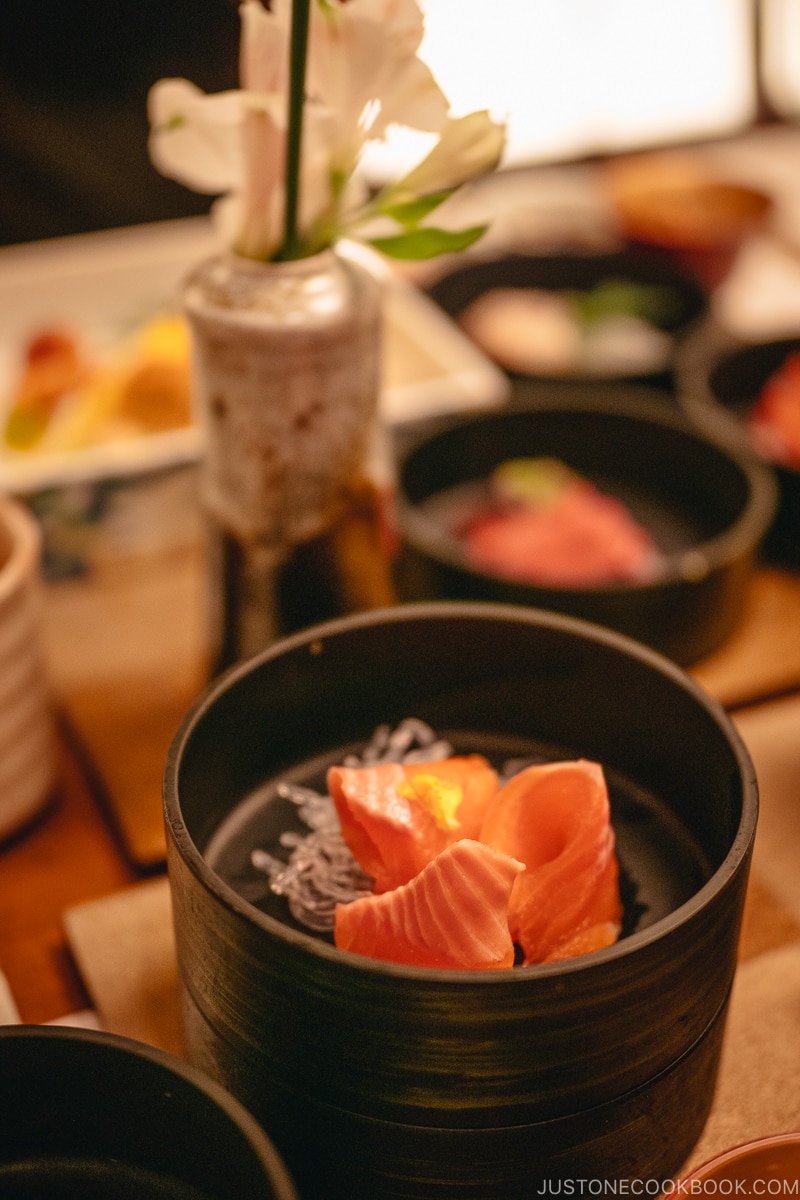
The restaurant ambiance. You may see motifs of plum or cherry blossoms during the spring, bamboo leaves and the Milky Way during the summer, autumn foliage during the fall, and snow during the winter.
As your meal progresses, do take a few moments to absorb the curated environment that surrounds you.
The Courses Served at Kaiseki Ryori
In this article, we will focus on the banquet dinner Kaiseki (会席). Note that Cha-Kaiseki does follow a similar course distribution but differs in rituals depending on the tea ceremony schools.
At a Kaiseki meal, the order of the dishes is mostly the same, although some restaurants may swap the order, and some may skip one or two courses. Each course is served one at a time and portions are bite-sized. After clearning the food, a new dish will be served. Now let’s take a look at what you may encounter.
Kaiseki Ryori Starters
1. Sakizuke (先付):
Bite-sized appetizer similar to an amuse-bouche.
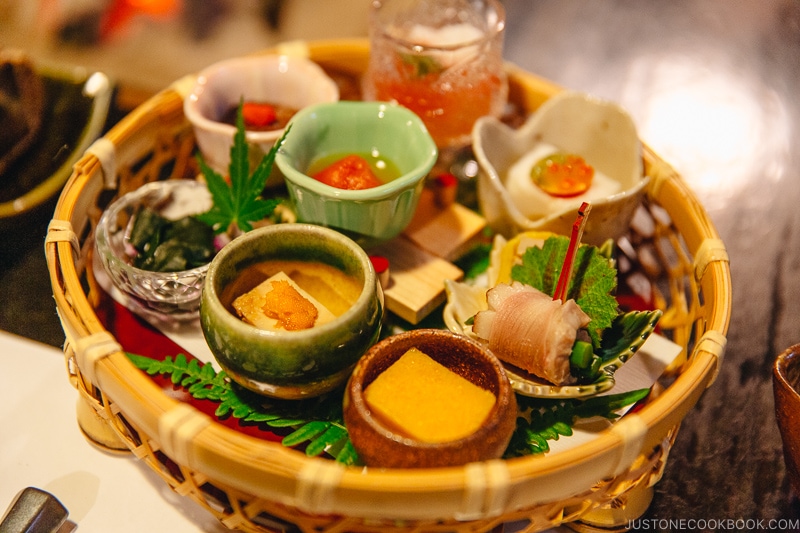
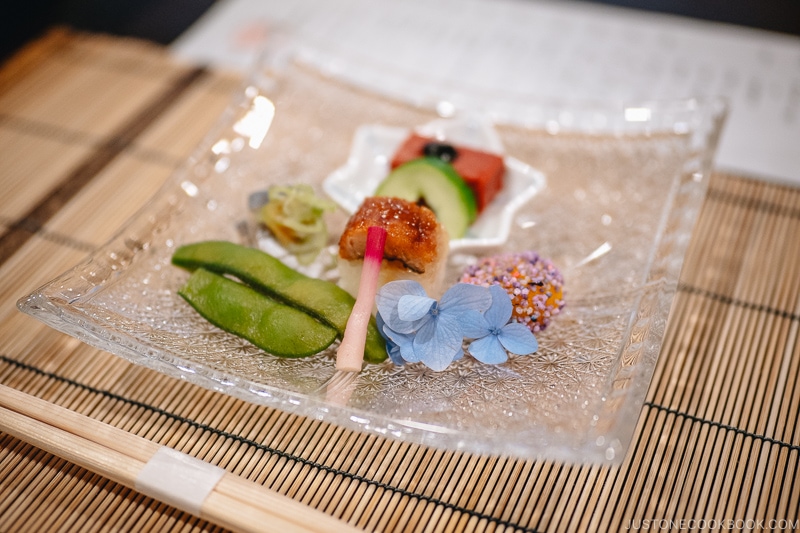
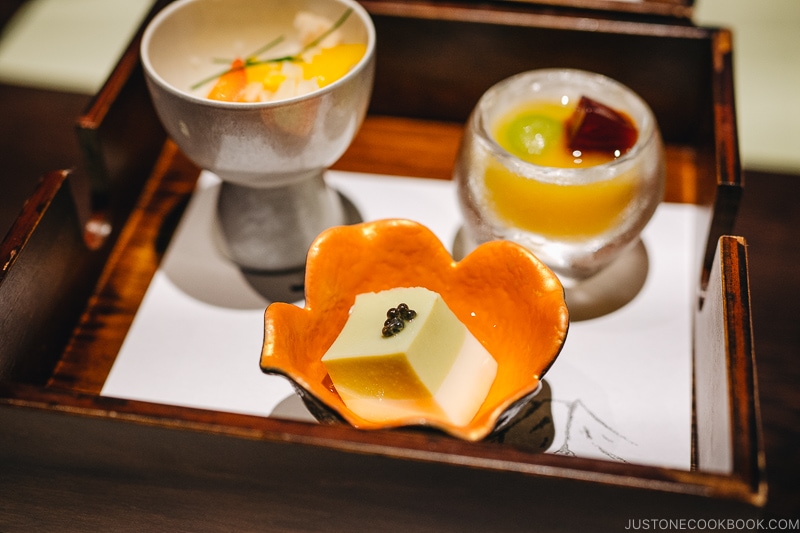
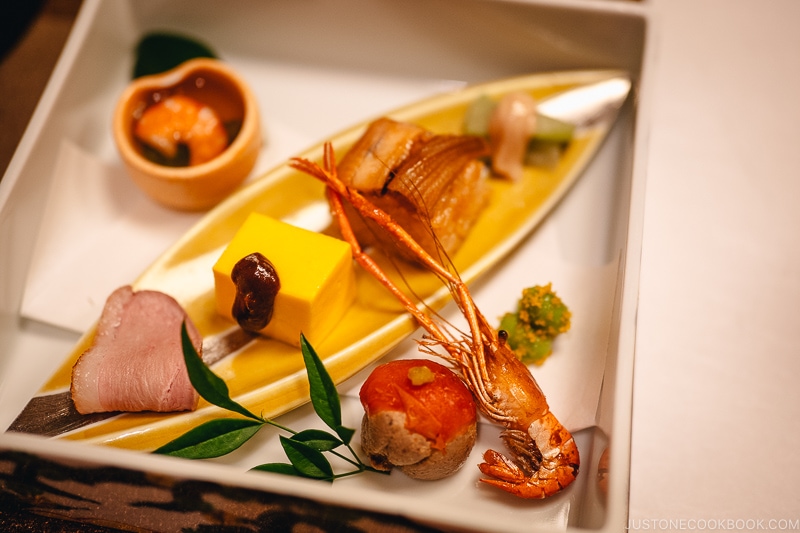
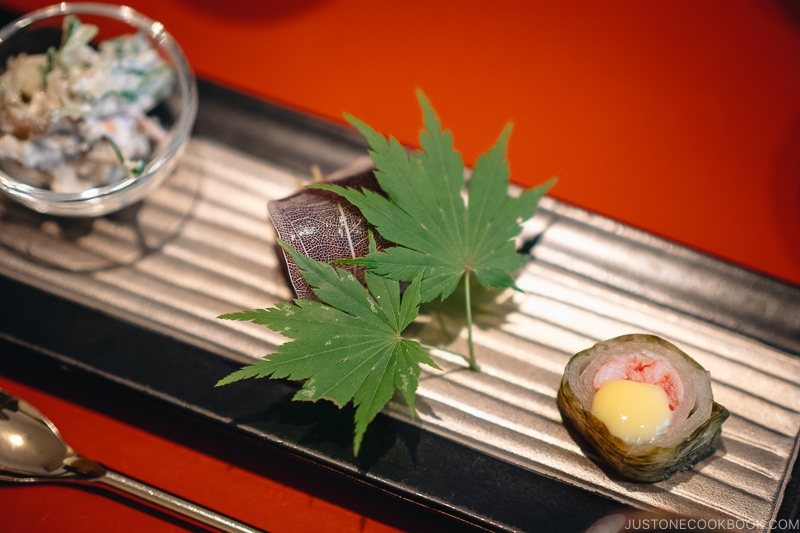
2. Shokuzen-shu (食前酒):
A glass of alcohol served with the Sakizuke, usually Sake (日本酒) or Umeshu (梅酒; plum wine). Some restaurants may offer non-traditional drinks such as sparkling wine or local beer.
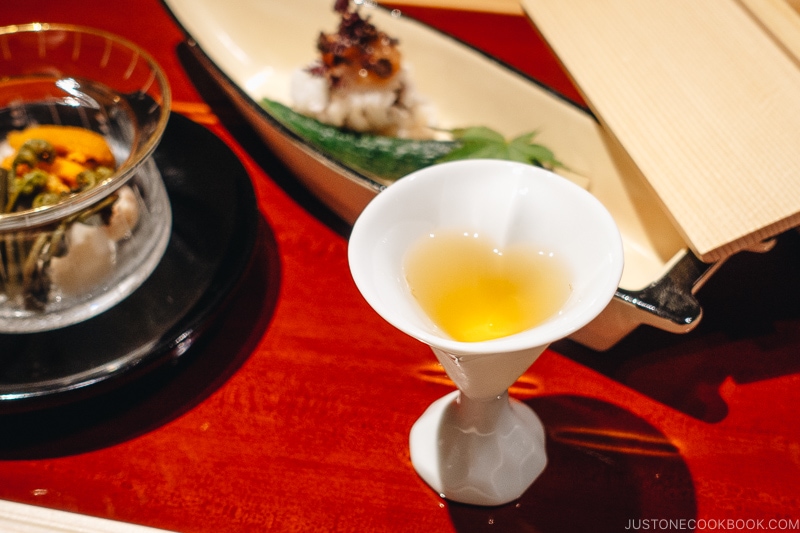
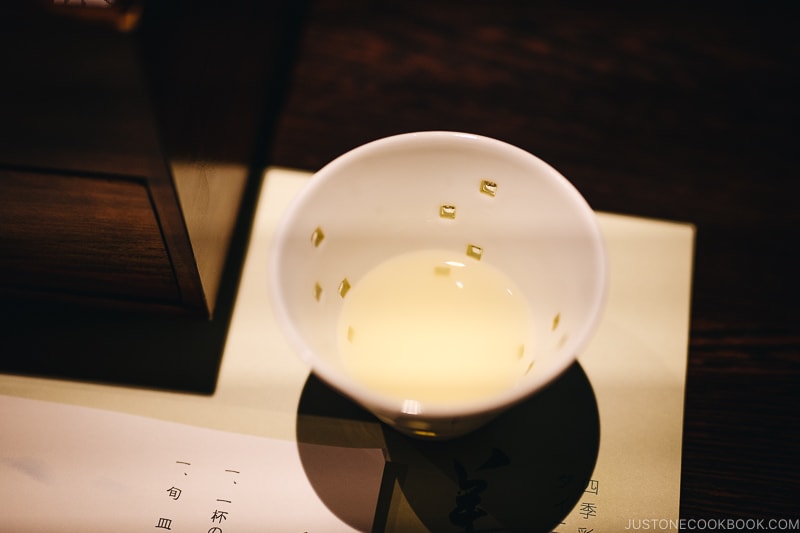
Kaiseki Ryori Main Courses
1. Wan-mono/Owan (椀物/御椀):
Lightly seasoned soup for cleaning your palate.
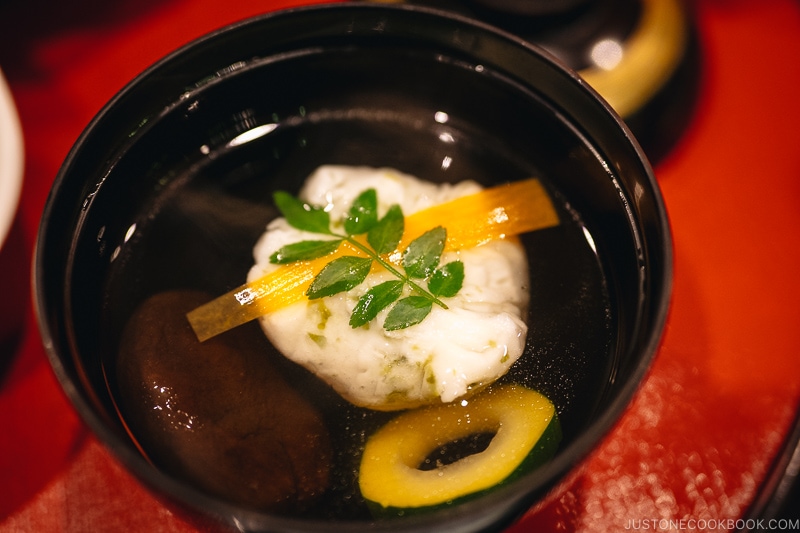
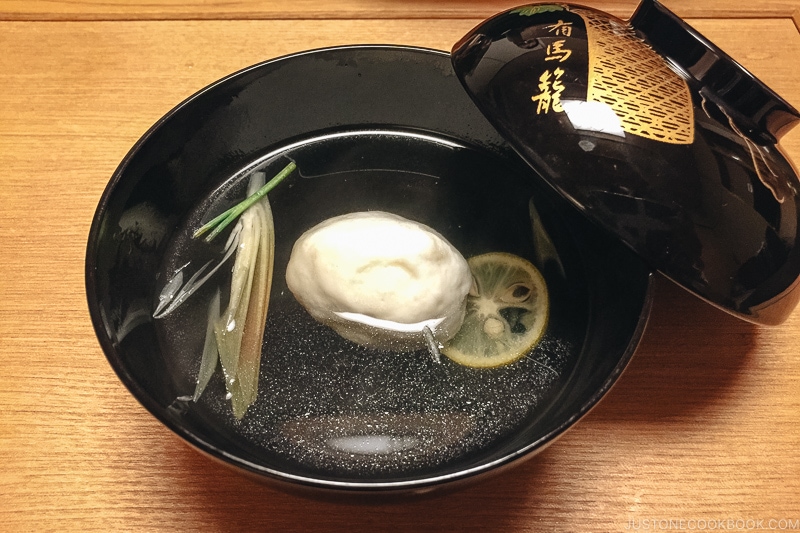
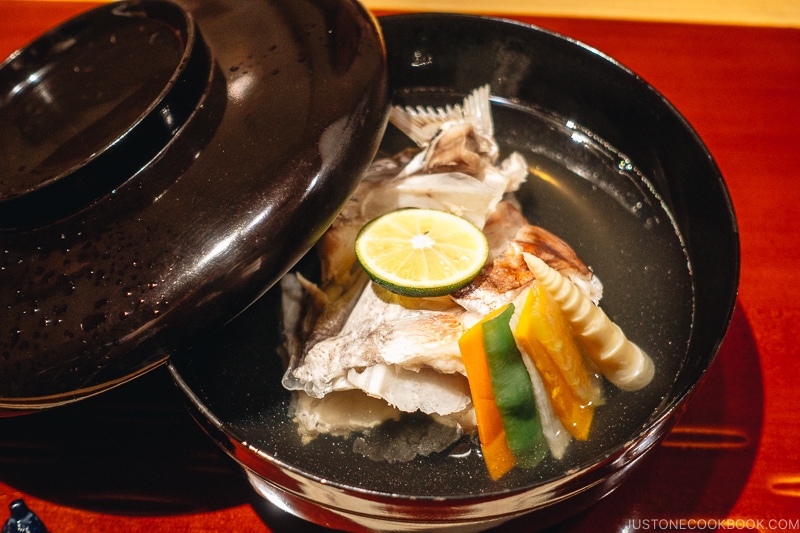
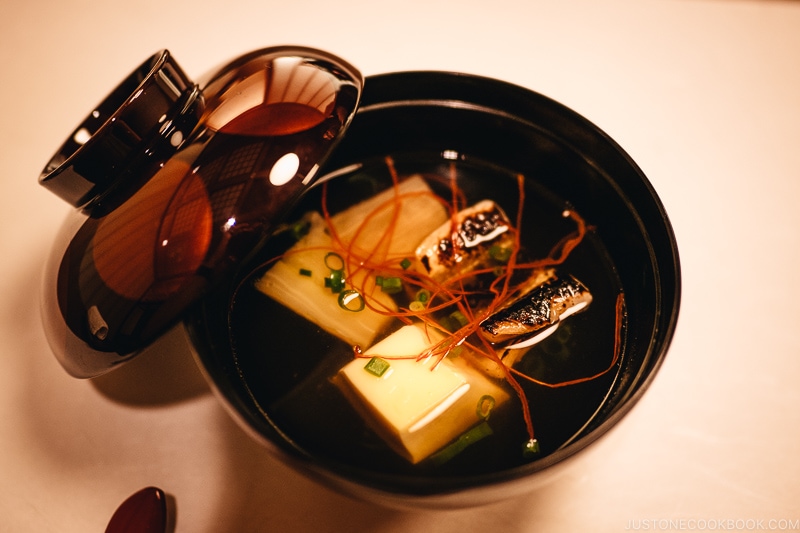
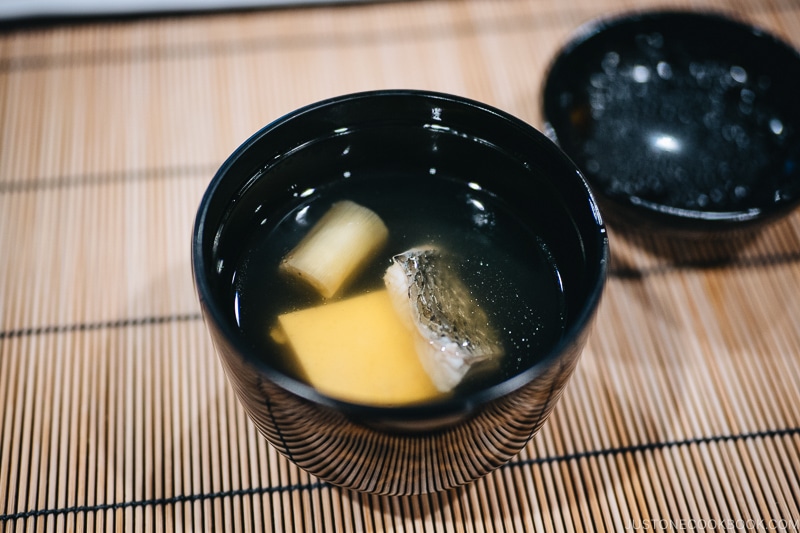
2. Mukozuke (向付):
Selection of seasonal sashimi (slices of raw fish or seafood), usually 2~5 varieties. Some places may serve different types of soy sauce or dipping sauce for each type of offering.
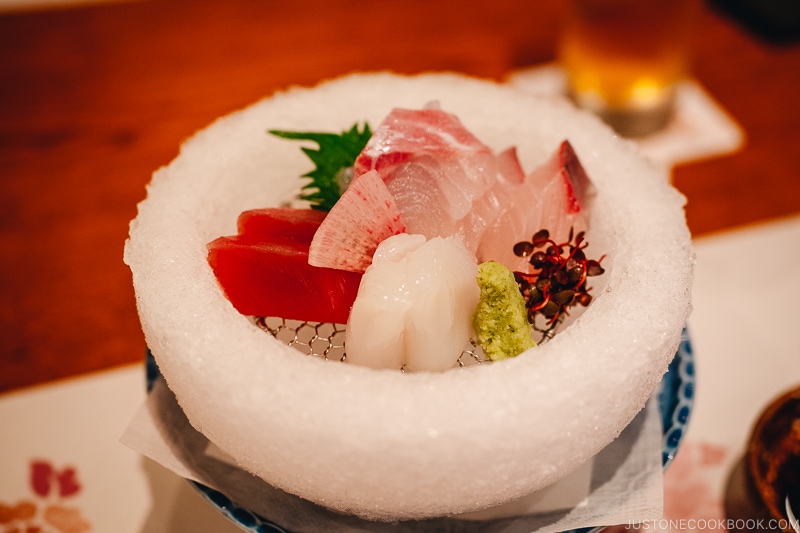
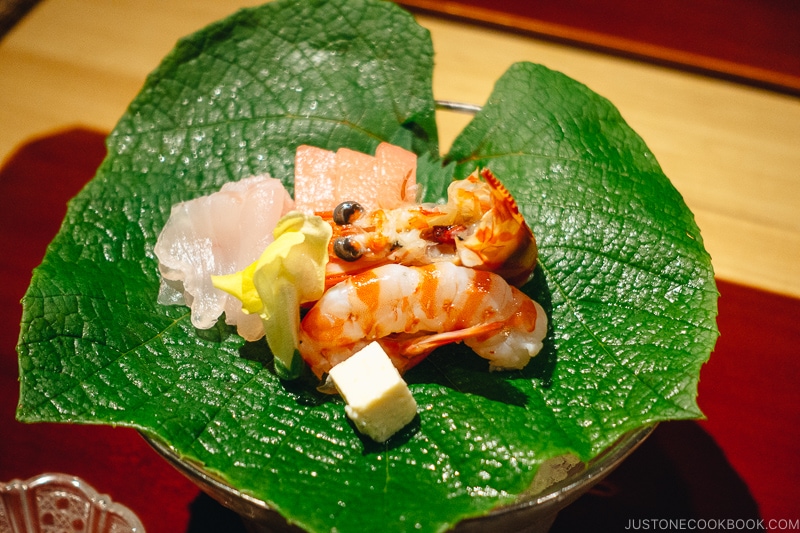
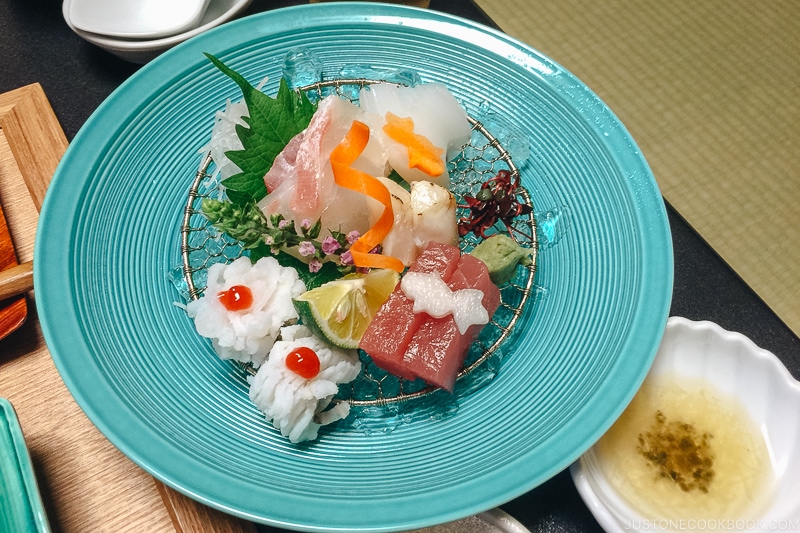
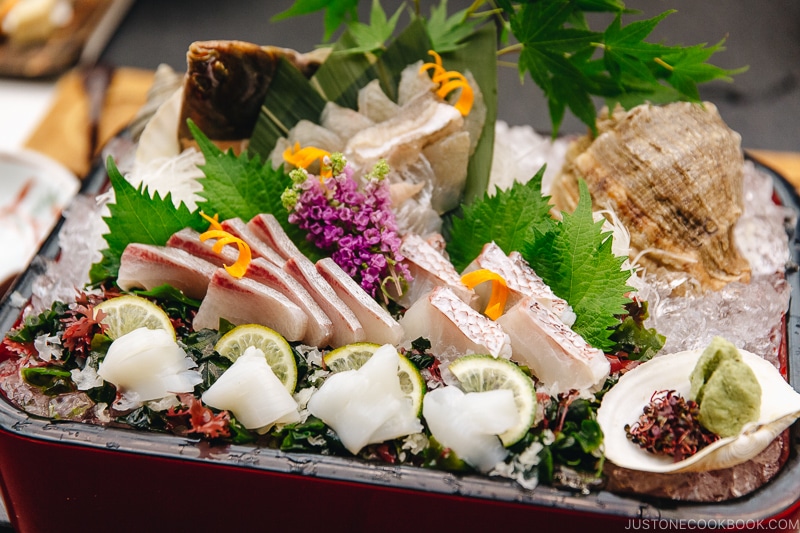
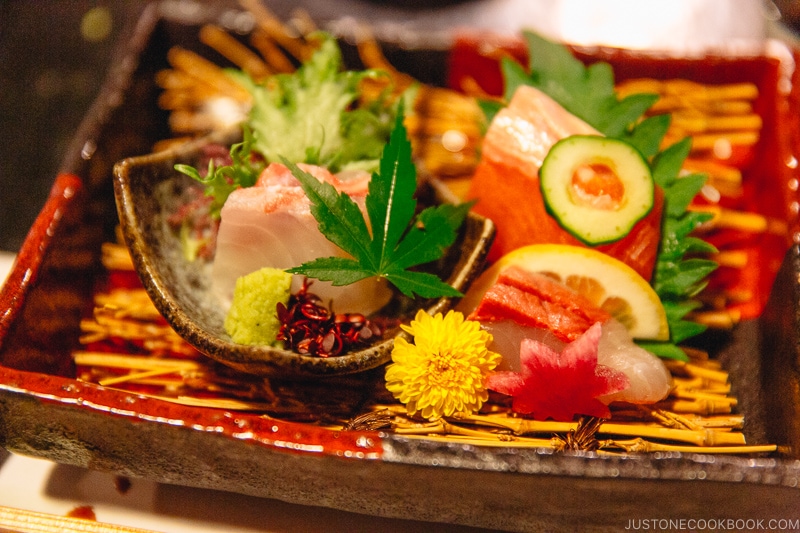
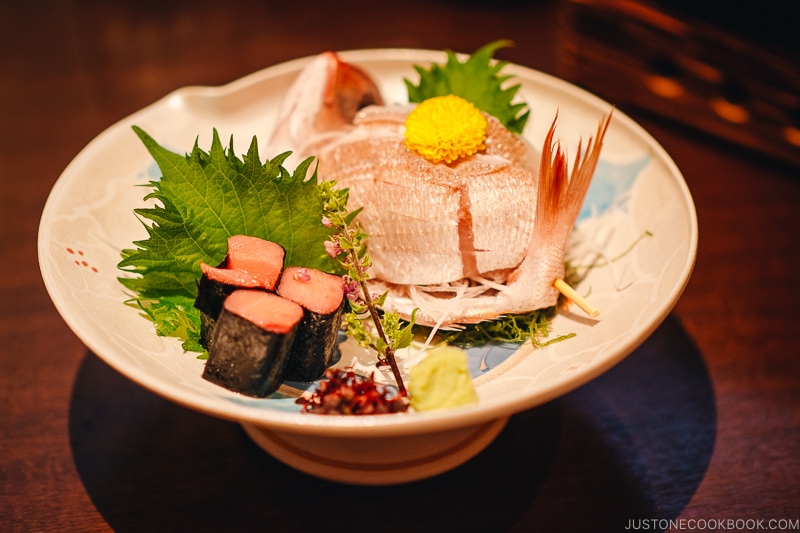
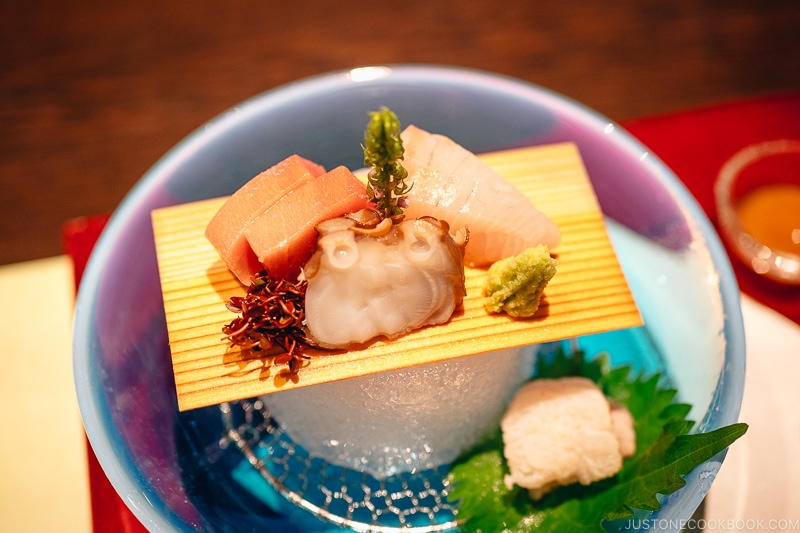
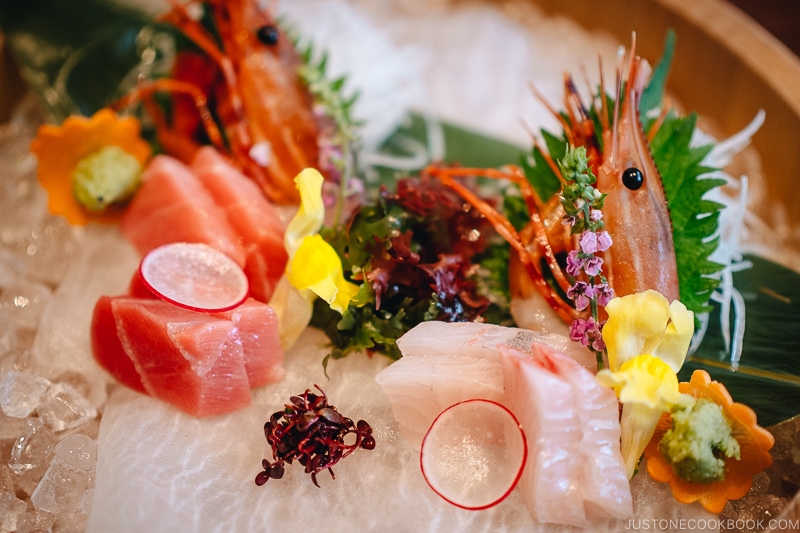
3. Hachizakana (鉢肴) or Yakimono (焼き物):
Features regional and seasonal fish, seafood or meat.
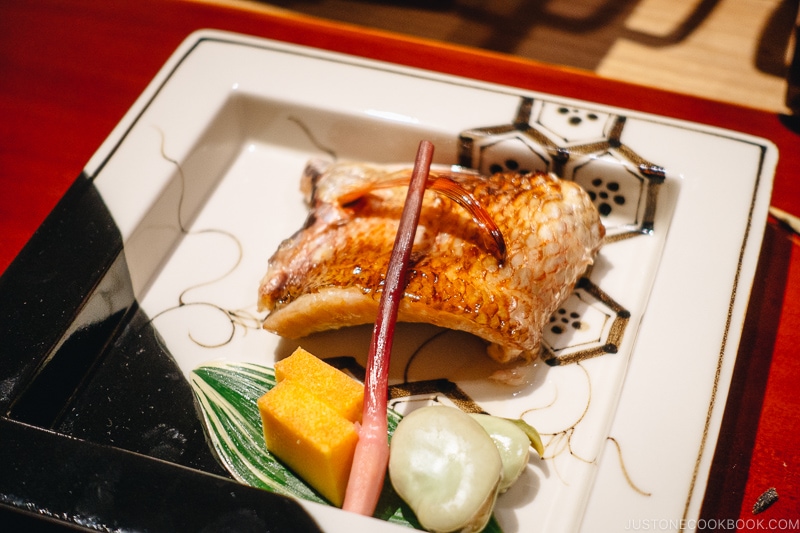
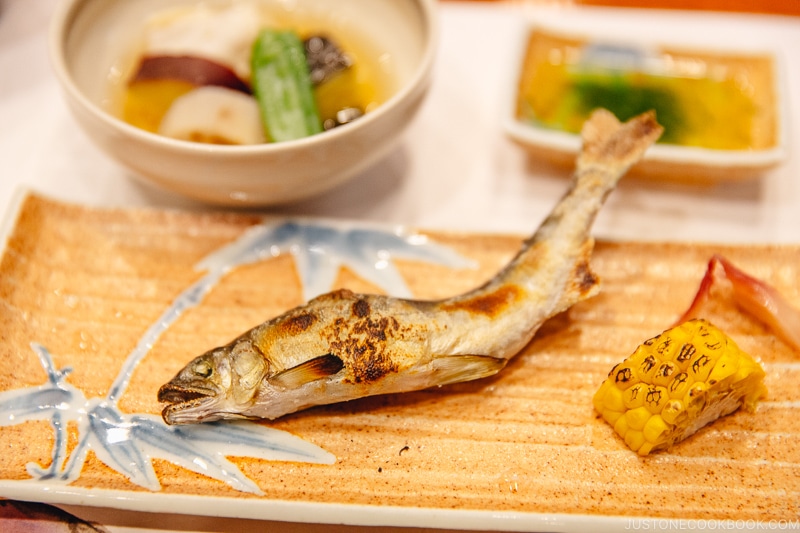
4. Sunomono (酢物):
A light vinegary dish that serves as a palate cleanser.
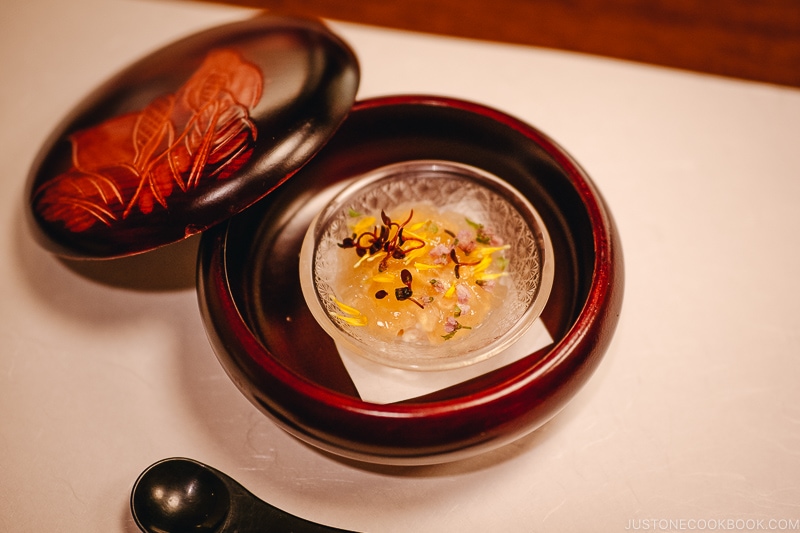
5. Shiizakana (強肴) or Takiawase (炊き合わせ) or Nimono (煮物):
A simmered dish which contains an assortment of vegetables along with a protein. The ingredients are cooked separately to preserve its distinctive textures and colors then put together on the plate.
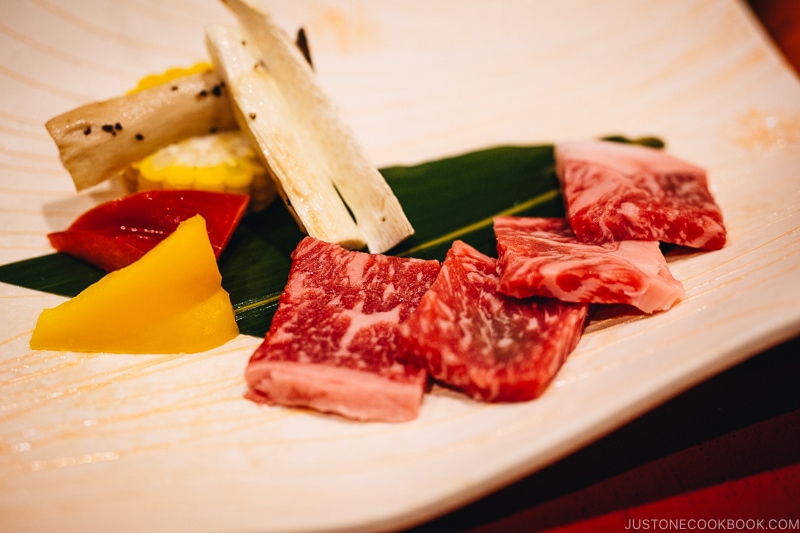
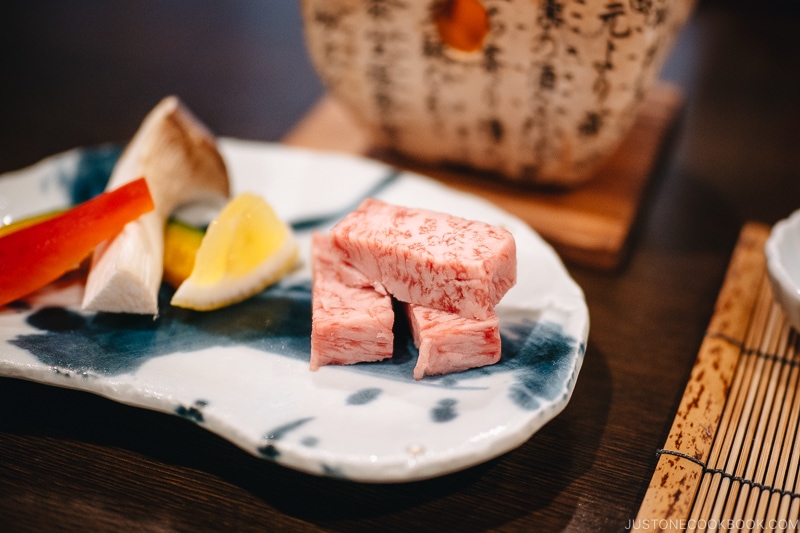
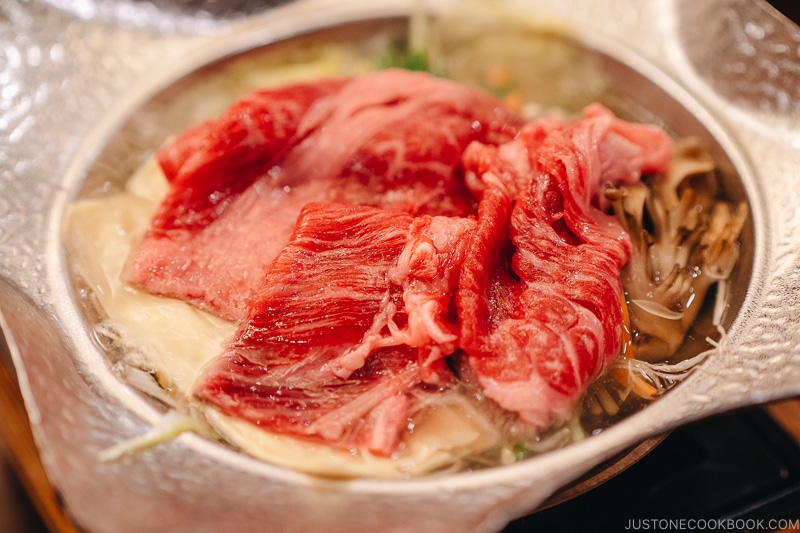
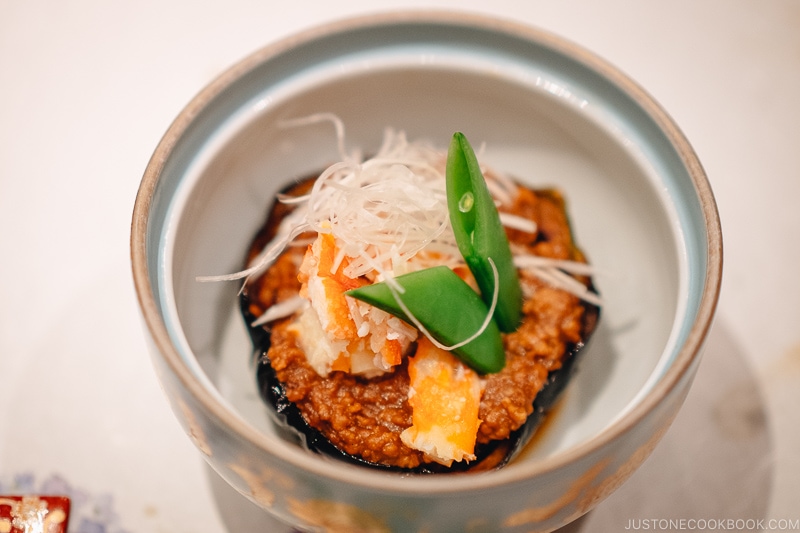
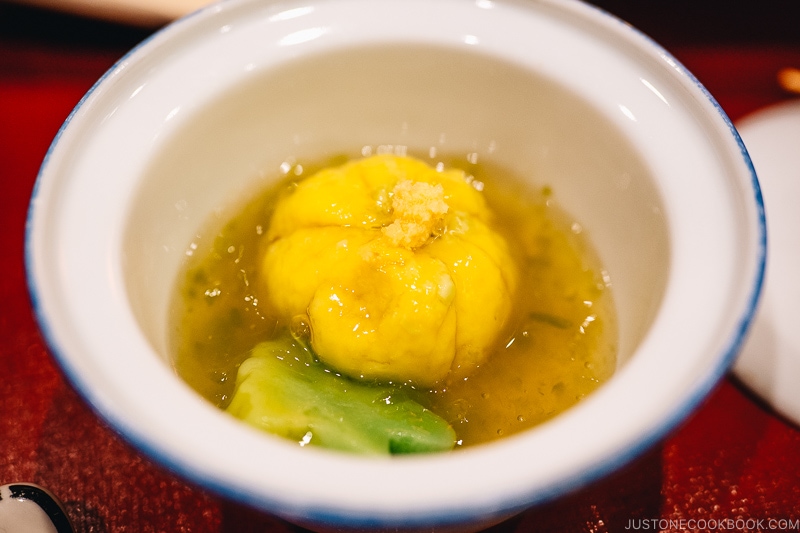
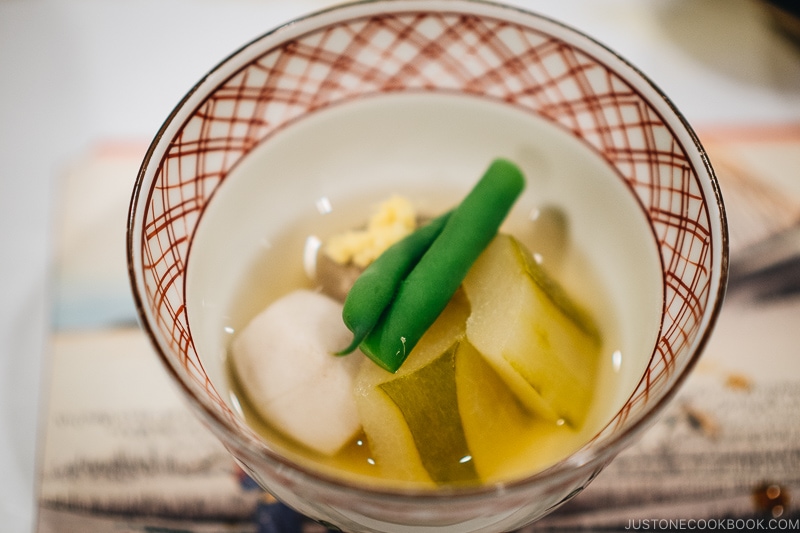
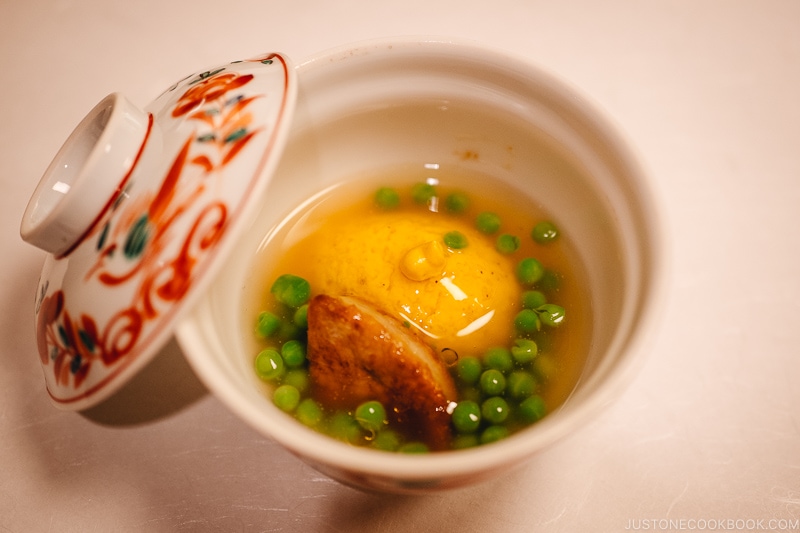
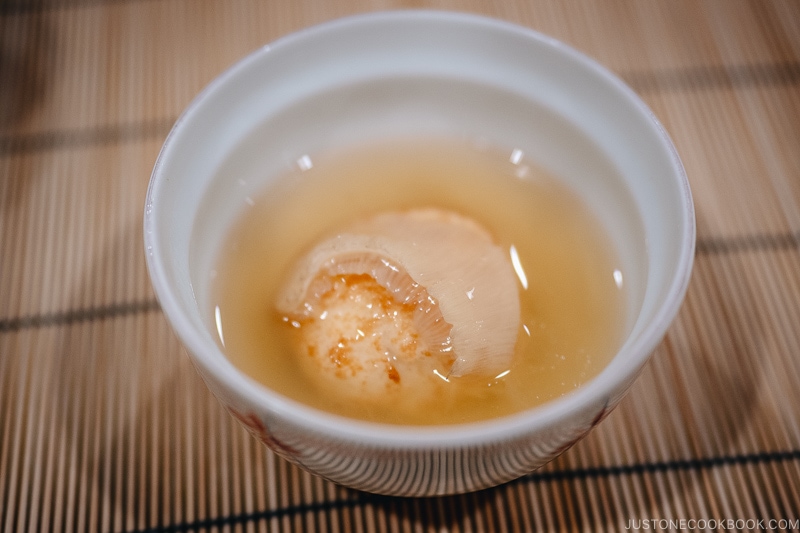
6. Agemono (揚物):
Usually, vegetables or fish that’s fried and some places may serve Tempura (天麩羅).
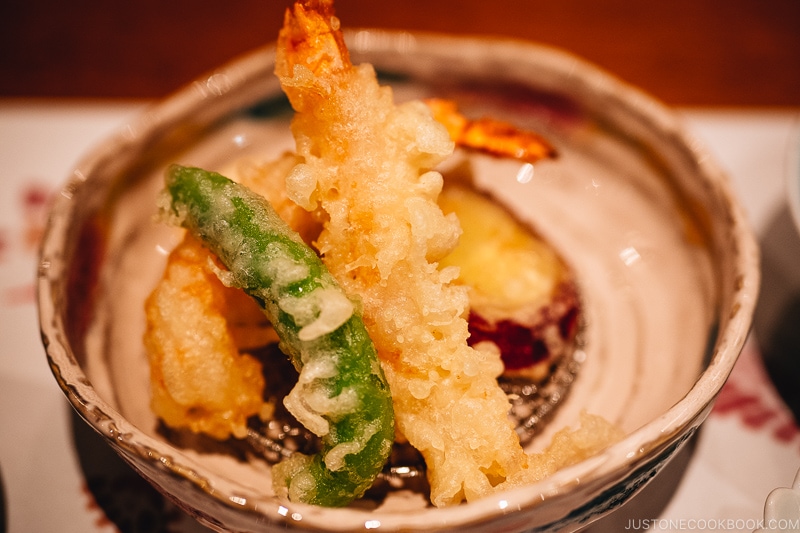
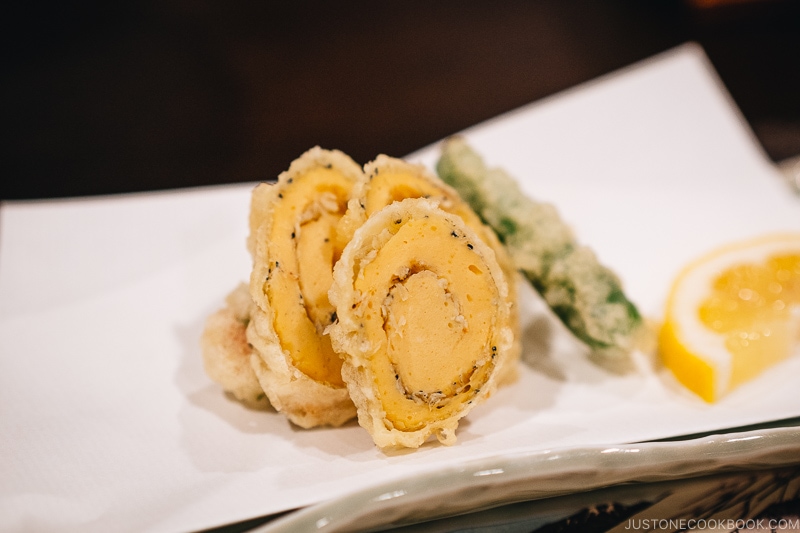
7. Mushimono (蒸物):
A steamed dish such as Chawanmushi (茶碗蒸し; steamed egg custard), fish cakes, or root vegetables.
8. Oshokuji (御食事):
The last course before dessert. It features the foundation to a Japanese meal: rice (plain or seasoned), miso soup and tsukemono (漬物; Japanese vegetable pickles).
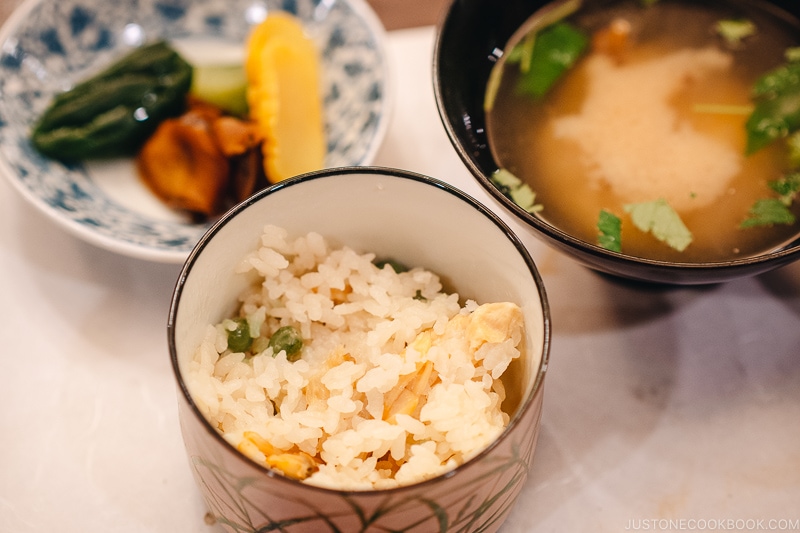
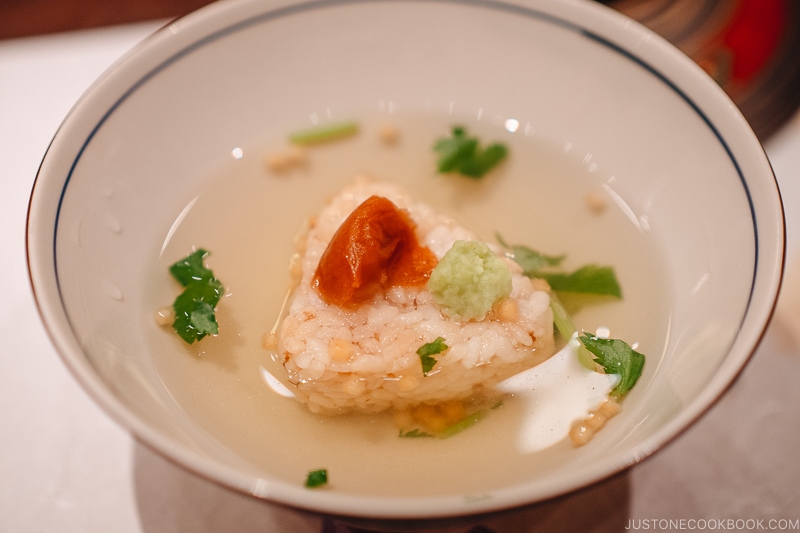
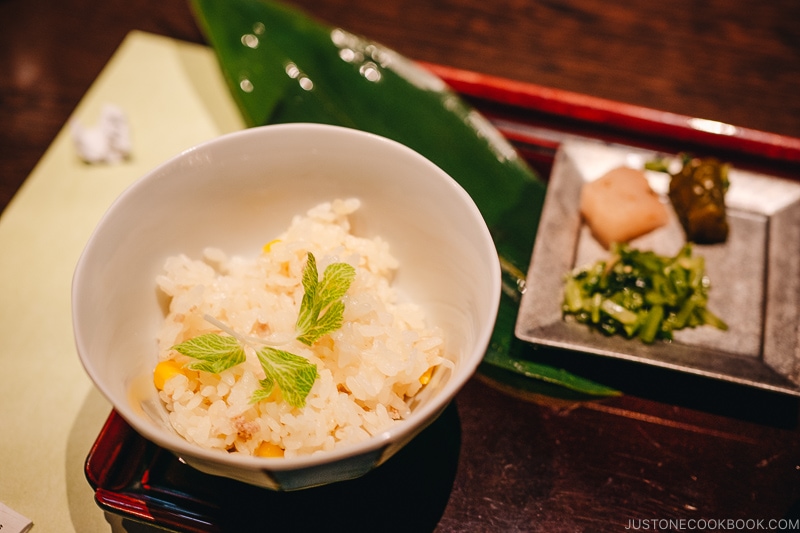
This miso soup is called Tomewan (留椀). It refers to the soup ending the meal to distinguish it from the soup served earlier.
Your host/servers will stop serving you alcohol at this point as it is the signal ending your course.
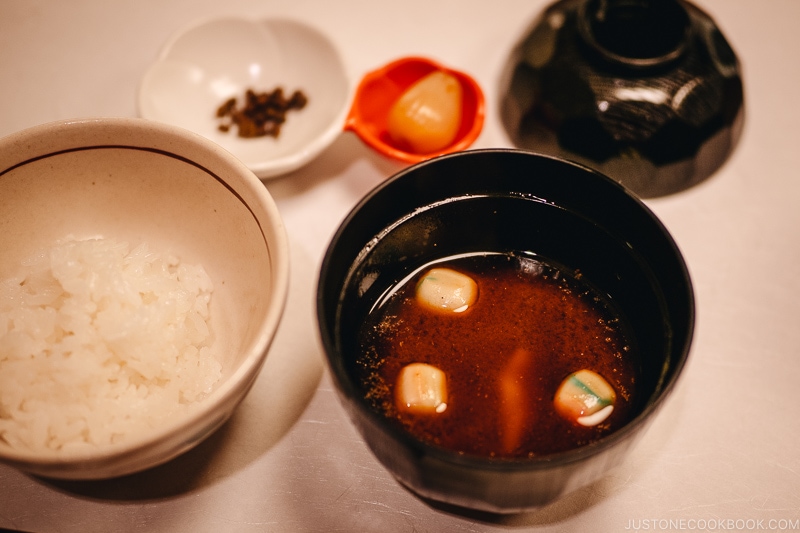
End of Kaiseki Ryori Meal
Mizugashi (水菓子) or Kanmi (甘味):
A light fruit-based dessert. Some may simply serve cut fruit, other places may serve elaborate jelly, sherbet or cake. This last dish is served usually with Hojicha (ほうじ茶 roasted green tea).
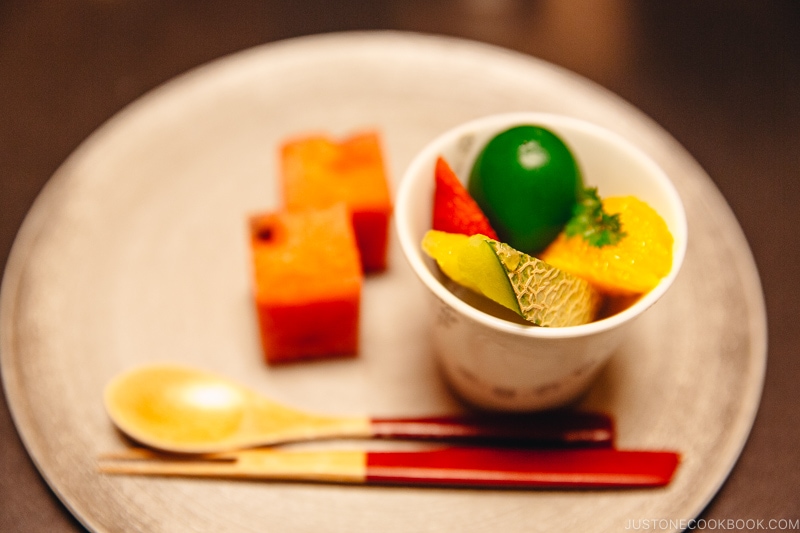
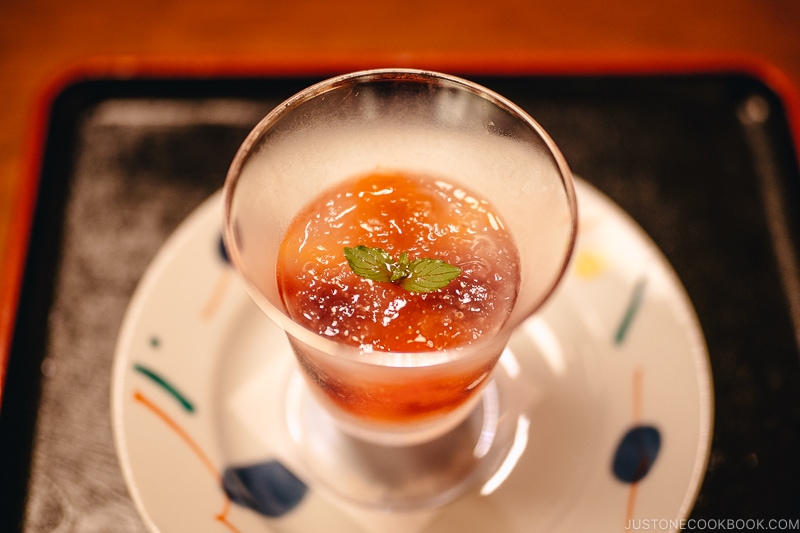
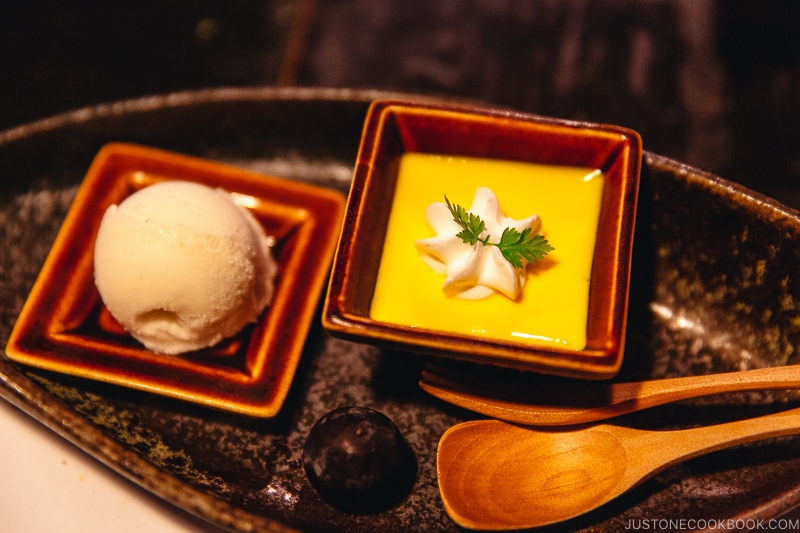
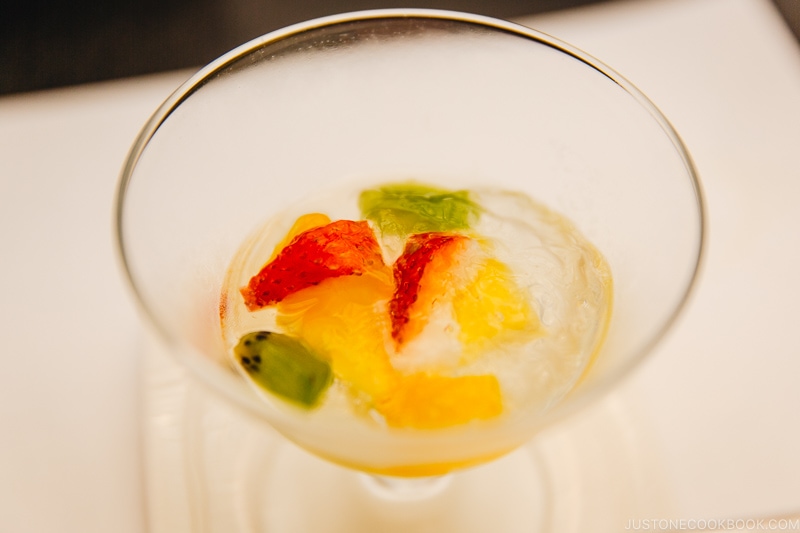
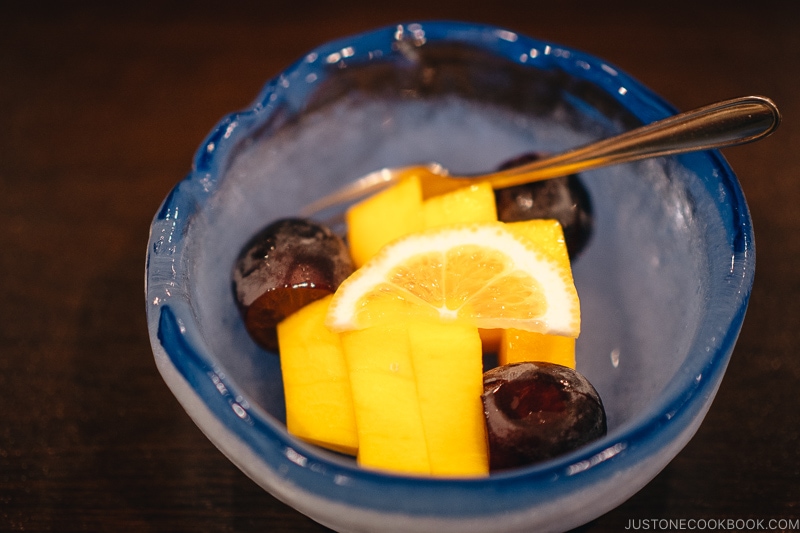
Seasonal Offerings
During the winter season, some restaurants may offer a hot pot course after the first few dishes, skipping the others entirely.
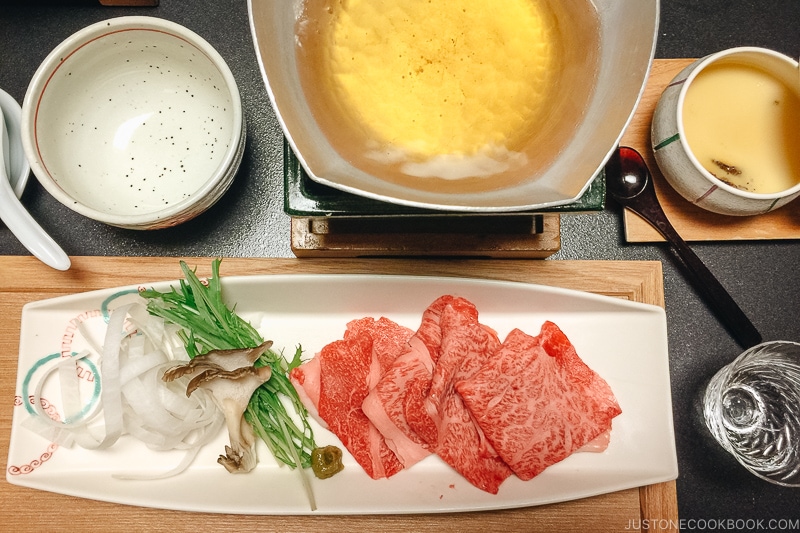
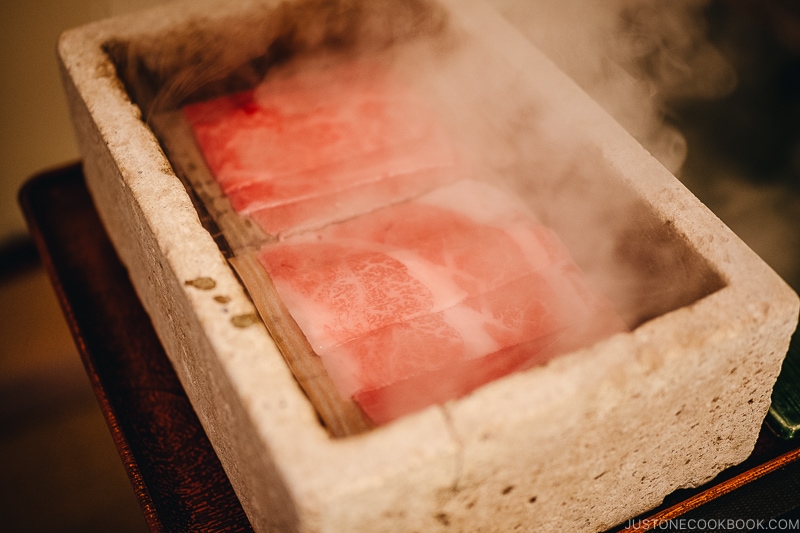
Areas famous for their local produce such as beef, pork or particular seafood may serve a special course. For example, the JOC family enjoyed a Hida beef Teppanyaki course during their travel to Hida Takayama, a region famous for their black-haired Japanese cattle breed.
Dining Etiquette at a Kaiseki Ryori Restaurant
So after reading through all the tantalizing dishes served at a Kaiseki restaurant, you’ve searched for dining options and made a reservation! But before you enter the restaurant, you want to know the rules and etiquette of dining without raising eyebrows. Here are some guidelines you could observe:
What should I wear? What should I avoid?
Treat a meal at a Kaiseki restaurant like dining at a 3 star Michelin restaurant. Wear clothing that’s comfortable but respectable to the place. You may be required to remove your shoes upon entry so wear shoes that are easily slipped on/off . Walking barefoot on tatami mats is a big no-no, as your bare feet may rub the dirt and sweat into the tatami mats (and tatami mats are notoriously hard to clean!) Come wearing socks, stockings, or tights. If wearing slippers, take them off at the entrance of the room.
Avoid wearing cologne or perfume. It is said that strong smells are distracting to the chefs and your fellow guests.
If you’re dining at a Ryokan (旅館; Japanese inn), you may be able to dine in the Yukata (浴衣; cotton Japanese robes) supplied in your room. You may have your meal served in your room or at a dining room. Ask in advance if wearing a Yukata outside of your room is acceptable.
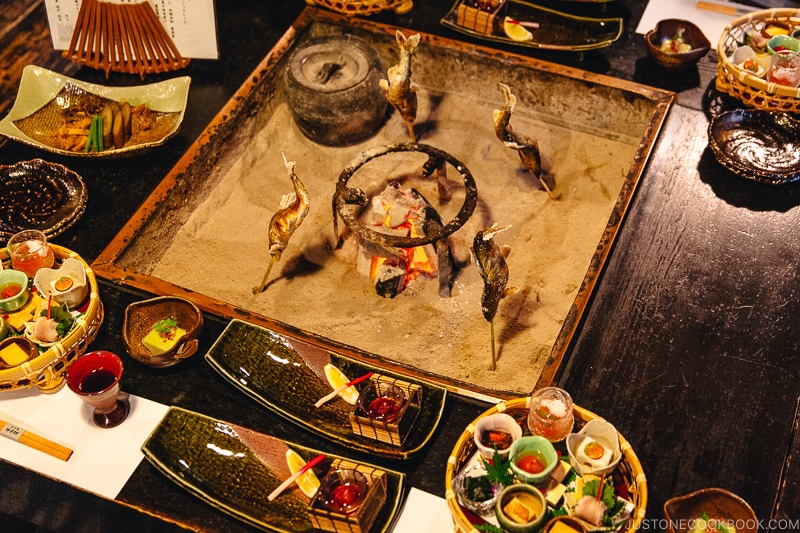
Can I take photos?
Ask the hostess or server if it’s okay to take photos. Most places would say yes but no flash or photos of your fellow diners (to protect their privacy). Some chefs may be happy to snap a photo with you at the end of the meal, some may not.
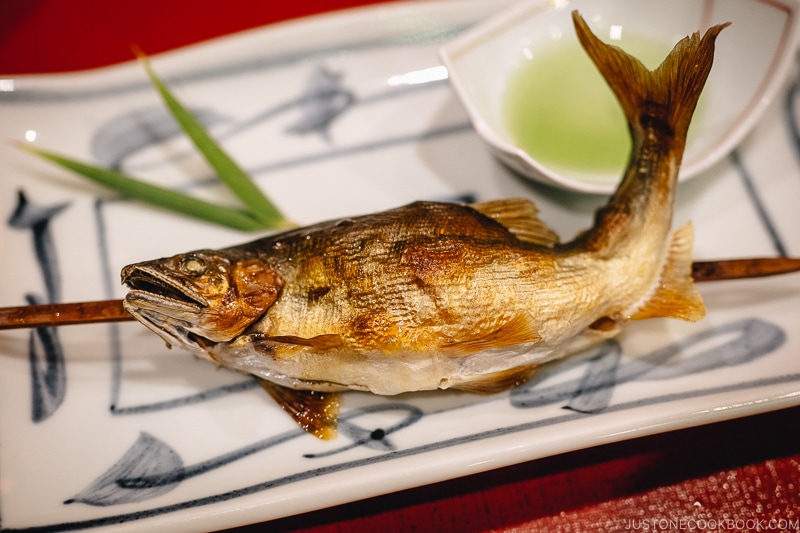
What are some of the dining etiquettes I should be aware of?
This article on Japanese Dining Etiquette 101 and Part 2 should hopefully answer your questions regarding dining etiquette in Japan. Feel free to ask away in the comment box below should you have more!
I have food restrictions (pescatarian/vegetarian/vegan, religious, food allergies). Can I still dine at a Kaiseki restaurant?
Ask the restaurant before making a reservation or check the website if they can accommodate your dietary needs. Unfortunately, a lot of Japanese dishes contain fish and seafood products, this may be a challenge for some. For vegetarian/vegan diners, an option is to seek a Shojin Ryori (精進料理) restaurant (an upscale Buddhist cuisine that contains no animal or fish products). Halal certified restaurants are still rare, although you may see some restaurants in touristy areas.
I don’t drink alcohol, but should I drink?
There’s no need to drink sake or alcohol with your meal, so don’t feel pressured because of the occasion! The restaurant may have non-alcoholic alternatives, but sticking to water or tea is also fine.
Can I pair the meal with alcohol other than sake?
Sake is a natural choice, but some restaurants have begun offering sparkling wine or craft beers for the first drink. Some may offer interesting wine pairings. Ask your hostess for suggestions and be open to explore! If the restaurant doesn’t have a drink menu, don’t be surprised. Instead, tell the server what flavors you like (dry/sweet, light/full-bodied, chilled/room temperature/hot, etc).
Right before the last meal (Oshokuji), your hostess/server will stop serving you alcohol. Traditionally, there’s no dessert alcohol/digestive equivalent for the dessert course, although some restaurants may have dessert wines, port or brandy in stock.
Is tipping required or necessary?
Tipping is not commonplace in Japan. However, you may notice a “service charge” added to your bill, a practice seen at most high-end restaurants. This is typically stated on the restaurant website or at the bottom on the menu. Ask your hostess if you’re unsure.
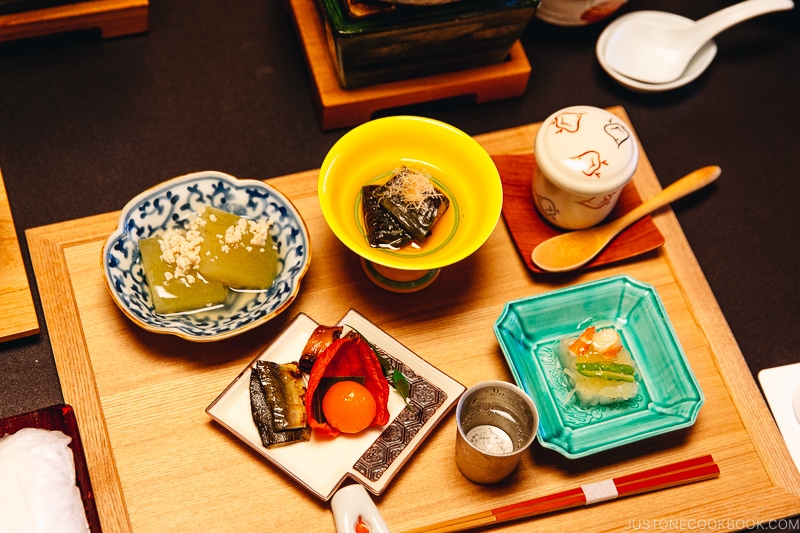
Where to Dine at a Kaiseki Restaurant
Ready to dine at a Kaiseki restaurant? In Japan, you’ll find many options in the big cities and the smaller towns as well. They range from world-renowned restaurants to local gems. Many of them are family-run and deeply steeped in local history. Conversely, others take a more modern interpretation of Kaiseki. You may notice non-Japanese produce and tableware incorporated into these new styles of Kaiseki.
Regardless of where you dine, you should always make a reservation, sometimes weeks or months in advance for the more popular restaurants. Keep in mind that whether or not you drink alcohol, it will be a costly meal. If you’re curious but don’t want to shell out the big bucks, you can always try the shorter and wallet-friendly lunch course.
Many Japanese inns (ryokan) offer a Kaiseki course for dinner. The cost is included in the room or added on as a surcharge. You can also scout for restaurants with the titles Ryotei (料亭) or Kappo (割烹) attached. Ryotei is exclusive restaurants where traditional entertainers called Geisha (芸者) or Maiko (舞妓) perform for the customers. Kappo is counter-seating restaurants.
The JOC family have featured their Kaiseki restaurant experiences on the blog, such as Den in Tokyo, Wakuriya in San Mateo, and Kyo-Arashiyama Nishiki in Kyoto.
Have you dined at a Kaiseki restaurant before? We’d love to hear your recommendations and experience!

Kayoko happily grew up in the urban jungle of Tokyo and in the middle of nowhere East Coast, U.S. After a brief stint as a gelato scooper and a slightly longer employment at an IT company, she decided to drop her cushy job to enroll in culinary school. Kayoko resides in Tokyo with her husband, a penguin pillow, and many half-dead plants. More from Kayoko →
